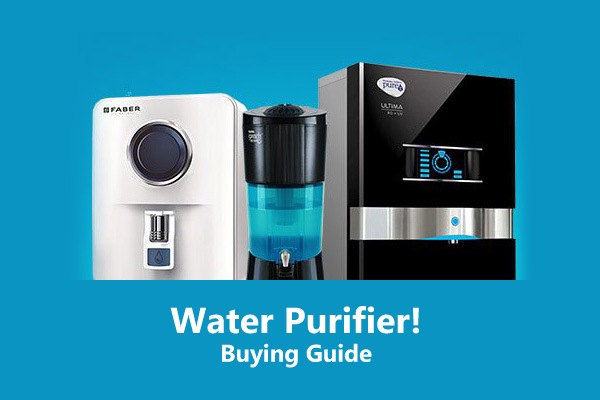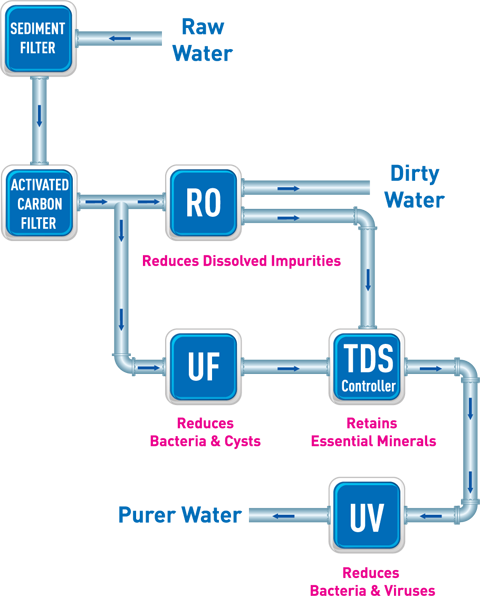Water is one of the essential stuff of our mother earth that is responsible for introducing life. We cannot imagine a single day without water. And fortunately, we are blessed with a sufficient amount of water. But the problem is we can use only 3% of the total water. And that most of the portion of that 3% is contaminated by many factors. So, we just can’t intake the water directly from the source. Hence we need a water purifier. And choosing the best one is none other than a hassle. But no more. As here is the ultimate Water Purifier Buying Guide.
So, if you are planning to take a new water purifier home then you must keep some conditions in mind. Don’t know what these conditions are? Well, for the answer you have to go through it. Hence, scroll now and choose the best and most appropriate water purifier. Start living healthy from today!
Different Sources Of Water & Water Pollution
First, you need to know about the different sources of water to understand the quality of the water that you use at your home, before going for any kind of water purifier. The sources are as follows,
The principal source of water on this planet is Rainwater. The basis of the groundwater table is formed by this rainwater. However, all the rainwater leaches through the porous space of soil and fills the groundwater table.
Another vital source is the snow. It melts and flows down the plains in the form of a river. A number of water bodies join a river before it merges into a sea or lake.
There are certain sources like ponds and other water reservoirs. These also provide soft water that we can drink or use for our daily deeds.
Pollution
Here go the sources of water. But the main issue is, that most of these sources are highly polluted by natural organisms or human wastes. Whenever a river comes down from a hill it starts gathering all the salts and minerals from the plain land, rocks, and sands. And all the wastes get dissolved in that water at this time. So the Total dissolved solids components get high in the water. Which is undoubtedly Hazaras for a human body. A high proportion of salts like sodium, potassium, chlorine, calcium, etc can lead to severe diseases.
Not only this process but also, some other processes are there to contaminate a water source. As in, when rain falls all the acidic materials of soil get dissolved in that water and leach through the permeable spaces of soil and mix into the groundwater. Thus groundwater gets polluted.
However, only some basic methods of pollution are enough to make you understand the importance of a water purifier. So, whenever you opt to buy a new purifier, you must go through our Water Purifier Buying Guide to make sure that you know exactly what you should check. Now, have a look at the most abandoned impurities of water and the acceptable TDS level water.
Types Of Impurities & Acceptable TDS Level Water
As you already know that there are some adamant salts, produced by human wastes, find their way to your kitchen through water resources. Now, it’s time to know the types of impurities in groundwater.
So many people are there who don’t use the water of a river or pond. So how do they get affected by water-borne diseases? Well, in this case, digging up and placing a pump to take out water from the groundwater table is the only option.
Then you may think, this water should be fresh, right? But you are wrong my friend because a lot of natural organisms are there to contaminate this water. Dead plants or animal matters, even phytoplanktons, zooplanktons all are responsible to provide you with undrinkable water.
As a whole, all these impurities are called TDS(total dissolved solids). And whenever this TDS level gets high it is completely unacceptable. But, if you think that drinking TDS-free water will cure your health then, you are wrong again. Because these TDS are important in your body growth. So, you need to intake a certain amount of TDS level. Here is a chart to let you know about the acceptable TDS levels. Look below.
The TDS level is measured in mg/L or ppm.
Excellent- When the TDS level is below 300ppm
Good- The TDS level is between 300 to 600pm
Fair- When the TDS level is in the range of 600 to 900ppm
Poor- TDS is between 900 to 1200ppm
Unacceptable- When the TDS level goes above 1200ppm
Below that 300mg/L or more than 1200mg/L is really harmful to human beings. So, only a water purifier can save you at this moment. And our Water Purifier Buying Guide is here to help you in choosing the best one.
Now that you know about all these impurities and total dissolved solids, it’s time to know how the water purifiers purify these types of polluted water.
Types Of Water Purification Technology
Based on the TDS level of water, the purification process of each water purifier is divided into three portions. The Ultra Filtration Technology(UF), RO (Reverse Osmosis) Technology, UV (Ultraviolet) Technology, EAT (Electro Adsorption Technology), a combination of a Universal Water Purifier. Have a look at the eccentricities of these purification processes and choose the suitable one.
UF (Ultra Filtration) Technology
All the gravity-based purifiers work on this purification method. Look below to know the key features of this process.
- The only type of water purifier certified to remove cysts
- Does not remove dissolved impurities
- Works without electricity
- Disinfection recommended
- Not an absolute barrier to viruses
The Ultra Filtration process is used in water that has less TDS level. But if you want something more convenient then you must check the other processes.
UV (Ultraviolet) Technology
One of the best purification processes of water is Ultraviolet technology. This UV ray is invisible to our naked eyes but it is a demon for the bacteria. However, let’s know why this process has set a benchmark.
- Fast disinfection process
- Sterilized microorganisms are not removed from the water
- It does not alter water chemically
- Does not remove dissolved organics, inorganics, or particles
UV energy penetrates the microorganism’s outer cell membrane and passes through the cell body by disrupting its DNA and preventing reproduction. If you want a purification process that removes dissolved materials, then you must go for the next process.
RO (Reverse Osmosis) Technology
This process is the most convenient one. All the viruses and bacteria get discarded in this process. Look down to know the key features.
- Effective when TDS rating is between 200 and 2000
- Purifies water of contamination caused by fluoride or other harmful chemicals and heavy metals, such as arsenic, lead, mercury
- Reduces the hardness of water which is caused by excessive calcium & magnesium salts
It squeezes water through the semi-permeable membrane of 0.0001 microns. RO purification process also desalinates seawater and makes it drinkable.
EAT Technology (Electro Adsorption Technology)
This purification technology has five advanced stages of purification. The electric and nonelectric variants are available, and some have storage tanks. It is ideal for water that has less than a TDS level of 500 ppm.
- First Stage – External Prefilter removes sand, silt, silica, dirt, and dust present in water and also enhances the life of the water filter
- Second Stage – Mechanical Filter removes dirt and other suspended solids through a sediment mesh
- Third Stage – Electro Adhesion Filter removes impurities that carry a negative charge, removes disease-causing cysts, germs such as bacteria and virus
- Fourth Stage – Ion Exchange, which has specially activated carbon granules, removes heavy metals like lead and arsenic
- Fifth Stage – Electro Adsorption removes harmful chemicals like chlorine, pesticides, and endotoxins
Now you know all about purification technologies. It’s time to know what you should check while buying a water purifier. The Ultimate Water Purifier Buying Guide is here to provide you with each relatable info. Have a look now.
The Ultimate Water Purifier Buying Guide
Before purchasing a water purifier you must keep in mind some factors. Look down to know what abilities a water purifier should have. Our Water Purifier Buying Guide will surely help you with that.
- Firstly, perform the TDS evaluation test to determine the level of TDS in your source of water, then buy a purifier that has the ability to remove that amount of TDs that you get in the test result
- Then conduct a chemical determination test to find out the exact percentages of the available chemical in the water that you are using for a long
- If you have doubt like your water may contain bacteria or viruses then you should purchase an RO + UV + UF water filter. Though these types of filters are pretty expensive still you can go for it to secure your health, Right?
- Finally comes your budget. Yes, it has a big role. As in, you have to keep in mind the cost of the purifier, then the maintenance cost, then the cost of replacement of the filters
If all things are sorted and go well then you can purchase your desired or required purifier now.
That’s all Guys! We can assure you that, if you follow this Water Purifier Buying Guide you will end up purchasing a suitable purifier. Need an advice if Nolvadex really also helps with treating infertility? Here https://www.childrenslymenetwork.org/children-lyme/buy-nolvadex-online-tamoxifen-at-lowest-price/ they state that it is only provided for breast cancer cases. But seen articles where there were some tests like this. Is it so, or just no chance? Can anyone confirm this? Would appreciate your advice. Oh and yeah, if there will be any advice on a good alternative, please tell me. So, make a note, compare water purifiers, and head to the store now!
FAQs
What are the things to consider when buying a water purifier?
Water quality, water pressure, and electricity are the three things that you should keep in mind when you are going to purchase a water purifier.
Is TDS required in a water purifier?
Yes, It is mandatory. As groundwater can have TDS up to 3000 ppm. So, you would need a TDS controller.
Do we need an RO water purifier?
It depends on the Water Quality. Water with 200 ppm is considered to be a very good quality of water. If you don’t have such water quality then you must go for RO.

